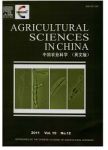Genetic dissection of crown root traits and their relationships with aboveground agronomic traits in maize
作者机构:College of AgricultureYangtze UniversityJingzhou 434000P.R.China State Key Laboratory of Crop Gene Resources and BreedingInstitute of Crop SciencesChinese Academy of Agricultural SciencesBeijing 100081P.R.China Institute of CropsGansu Academy of Agricultural SciencesLanzhou 730070P.R.China Institute of Maize ResearchInner Mongolia Academy of Agricultural&Animal Husbandry SciencesHohhot 010031P.R.China
出 版 物:《Journal of Integrative Agriculture》 (农业科学学报(英文版))
年 卷 期:2023年第22卷第11期
页 面:3394-3407页
核心收录:
基 金:supported by grants from the National Natural Science Foundation of China (31971891) the Guangxi Key Research and Development Projects, China (GuikeAB21238004) the Scientific Innovation 2030 Project, China (2022ZD0401703) the Modern AgroIndustry Technology Research System of Maize, China (CARS-02-03)
主 题:maize root aboveground agronomic traits GWAS candidate genes
摘 要:The crown root system is the most important root component in maize at both the vegetative and reproductive stages. However, the genetic basis of maize crown root traits(CRT) is still unclear, and the relationship between CRT and aboveground agronomic traits in maize is poorly understood. In this study, an association panel including 531 elite maize inbred lines was planted to phenotype the CRT and aboveground agronomic traits in different field environments. We found that root traits were significantly and positively correlated with most aboveground agronomic traits, including flowering time, plant architecture and grain yield. Using a genome-wide association study(GWAS)coupled with resequencing, a total of 115 associated loci and 22 high-confidence candidate genes were identified for CRT. Approximately one-third of the genetic variation in crown root was co-located with 46 QTLs derived from flowering and plant architecture. Furthermore, 103 (89.6%) of 115 crown root loci were located within known domestication-and/or improvement-selective sweeps, suggesting that crown roots might experience indirect selection in maize during domestication and improvement. Furthermore, the expression of Zm00001d036901, a high-confidence candidate gene, may contribute to the phenotypic variation in maize crown roots, and Zm00001d036901 was selected during the domestication and improvement of maize. This study promotes our understanding of the genetic basis of root architecture and provides resources for genomics-enabled improvements in maize root architecture.



